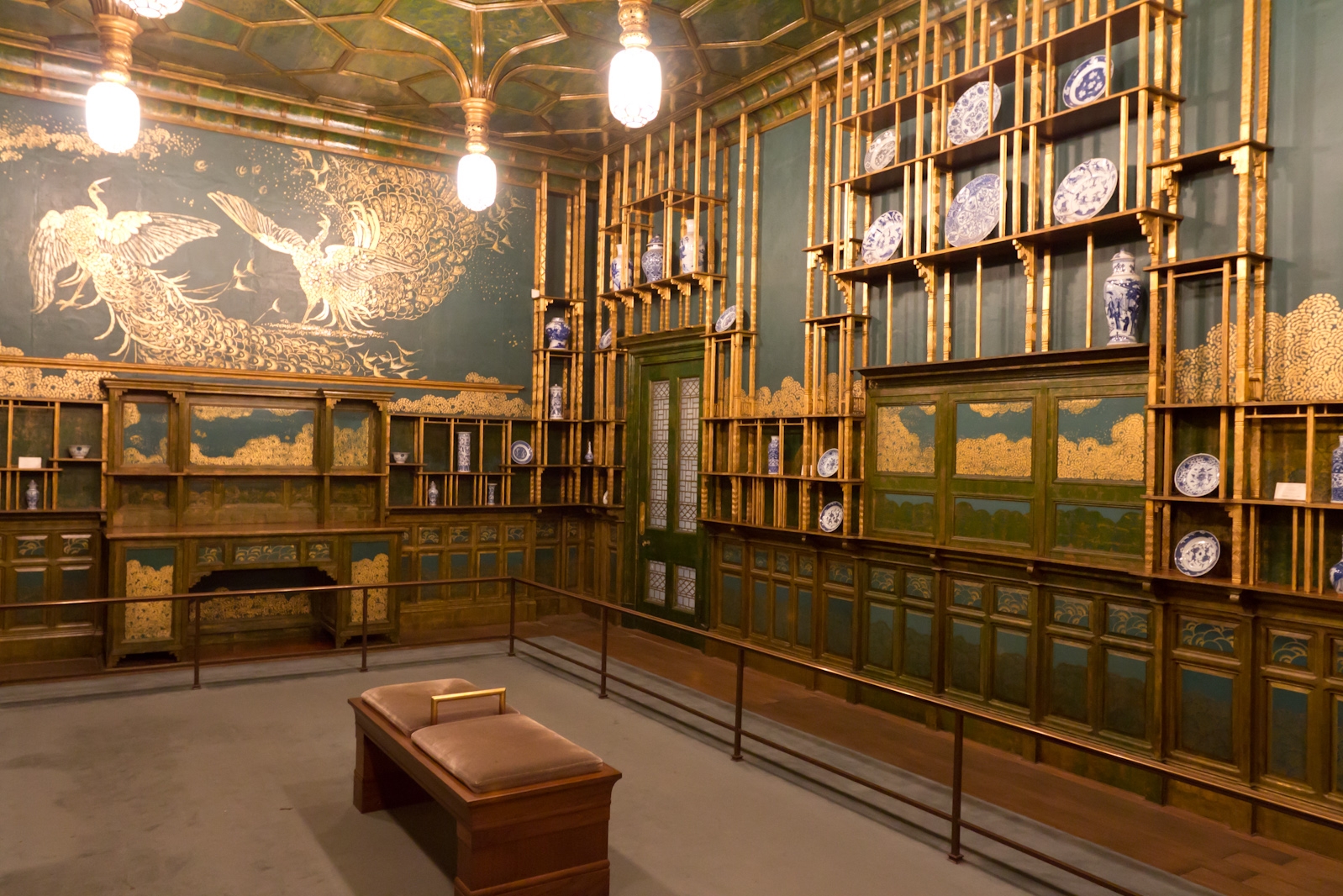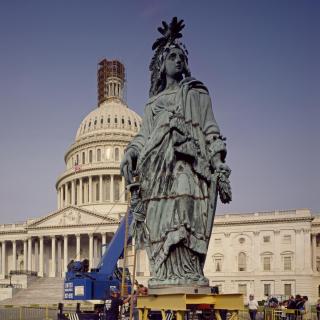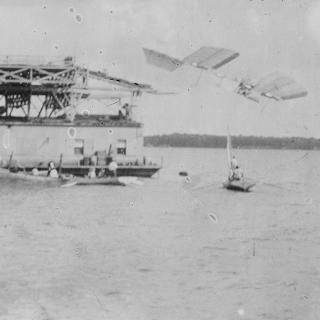How Teddy Roosevelt Brought Art to Washington: The President's Role in the Opening of the Freer Gallery
Artist James McNeill Whistler’s most famous painting is probably his portrait, Whistler’s Mother, but to Washingtonians, there is another work that captures the imagination.
Tucked away in a corner of the Freer Gallery, Whistler’s “Peacock Room” beckons people with its distinct lure. Victorian gas lamps, gilded patterns of gold, and Chinese pottery all come together to create quite a spectacle. This is not just a normal art exhibit, however. It's more of a story.
The Peacock Room was first designed by architect Thomas Jekyll in 1876 to serve as a dining room for the wealthy British shipping magnate Frederick Leyland. Since Leyland planned to make Whistler’s painting, Princesse du pays de la porcelaine the centerpiece of the room, he conferred with Whistler about some small design elements. The artist gave some suggestions and offered to help with the work. The flamboyant Whistler then promptly hijacked the project and repainted the room extravagantly, covering the walls with gilded patterns and ornate peacocks.[1] This caused some friction when he later asked Leyland for payment. However, the room became the talk of the London art scene and boosted Whistler's profile significantly.
So how did this treasure find its way to Washington? Well, it’s a little complicated.
In 1904, manufacturer-turned-art-collector Charles Lang Freer purchased the Peacock Room and had it taken apart, shipped across the Atlantic, and reassembled in his Detroit mansion. Soon, however, Freer began looking for a new home for his vast collection, which included thousands of pieces of Asian artwork and works by American artists, including a number of other Whistler paintings. In hopes of ensuring the collection would remain intact forever, he offered it to the Smithsonian Institution along with $500,000 to construct a suitable museum in the nation's capital.
Curiously, however, the Smithsonian dragged its feet. Supposedly, officials worried that they didn’t have the resources to properly care for the pieces.[2]
The city’s art community lamented the decision. As columnist James Henry Moser wrote, “One cannot believe that the Smithsonian Institution will leave any stone unturned or fail to make a strenuous effort to secure for Washington this collection. ... The collection of Whistlers, which includes the famous ‘Peacock Room,’ brought from London, is of such unique interest and art value, and likely to grow more so, that with the Corcoran Art Gallery already here, it would go far toward making Washington an art center.”[3]
The Smithsonian’s hesitance also caused waves at the White House. As the story goes, “When President Roosevelt received the report he pounded on his desk in characteristic fashion and demanded that they accept the gift and some means would be found to care for it.”[4]
To many, it may come as a surprise that, in addition to being an avid outdoorsman, and a Rough Rider, Teddy had an appreciation for fine art. Then again, considering that his father, Theodore Roosevelt, Sr., was a former director of the Metropolitan Museum of Art, perhaps it shouldn’t, but I digress.
Once he was done pounding on his desk, the President wrote a letter to Chief Justice Melville Weston Fuller, who also happened to be the chancellor of the Smithsonian.
“It is impossible to speak in too high terms of the munificence shown by Mr. Freer in this offer; and it is one which the government of the United States should close at once as a matter of course. Mr. Freer’s collection literally is priceless; it includes hundreds of the most remarkable pictures by the best known old masters of China and Japan. It also includes hundreds of pictures, studies, and etchings by certain notable American artists; those by Whistler alone being such as would make the whole collection of unique value.”[5]
He continued:
“The offer is one of the most generous that has ever been made to this government, and the gift is literally beyond price. All that is now asked is that we shall agree to accept, on behalf of the nation, the great benefit thus to be bestowed on the nation. I hope that the regents of the Smithsonian will feel warranted to close with the offer, for they are the national guardians of such a collection. If in their wisdom they do not see their way to accept the gift, I shall then be obliged to take some other method by endeavoring to prevent the loss to the United States government, of one of the most valuable collections which any private individual has ever given to any people.”[6]
President Roosevelt was a very persuasive man. On January 24, 1906, the board of regents voted to accept the collection, which was believed to be the largest ever given by one individual to any national museum in the world.[7] Washington’s art community was thrilled. As a Post editorial later exclaimed, “President Roosevelt, by prompt and decided action where the Smithsonian Institution was dilatory and vacillating, has acquired for Washington the nucleus of a national art gallery and thereby won the gratitude of every lover of art, of whom Washington contains many.”[8]
After several years of planning — which included Mr. Freer raising his cash commitment to $1,000,000 — construction on the museum began in September of 1916. Although World War I halted progress for a time, it was completed and opened to the public in May 1923. The Peacock Room was a particularly popular exhibit in the early days and remains so today.
One last addendum to the story. ... Though James McNeill Whistler was born in Massachusetts and lived most of his adult life overseas, the Freer Gallery saga that brought his work to the nation’s capital was a homecoming of sorts. He had actually lived in Washington for a time in the early 1850s before he became an accomplished artist. Back then he was a twenty-something West Point flunkout working at the United States Coast Survey. Supposedly he was fired after it was discovered that he was engraving caricatures in the margins of official Coast Survey plates.[9]
Once an artist, always an artist!
Footnotes
- ^ "The Peacock Room Comes to America." Freer-Sackler The Smithsonian's Museums of Asian Art. 2014. http://www.asia.si.edu/exhibitions/current/PeacockRoom.asp.
- ^ “Art and Artists,” The Washington Post, 14 Jul 1918: E12.
- ^ Moser, James Henry, “Washington May Lose Great Art Collection,” The Washington Post, 16 Apr 1905: T4.
- ^ "Art and Artists"
- ^ “Likes Freer’s Gift: President Urges Acceptance of Fine Art Collection,” The Washington Post, 26 Dec 1905: 1.
- ^ “Likes Freer’s Gift: President Urges Acceptance of Fine Art Collection”
- ^ “Freer Gift Accepted,” The Washington Post, 24 Jan 1906: S1.
- ^ “Complete the Work,” The Washington Post, 27 Oct 1907: E4.
- ^ “Peacock Room Came From Leyland Home,” The Washington Post, 30 May 1923: 6.








![Sketch of the mythical fuan by Pearson Scott Foresman. [Source: Wikipedia]](/sites/default/files/styles/crop_320x320/public/2023-10/Goatman_Wikipedia_Faun_2_%28PSF%29.png?h=64a074ff&itok=C9Qh-PE1)












